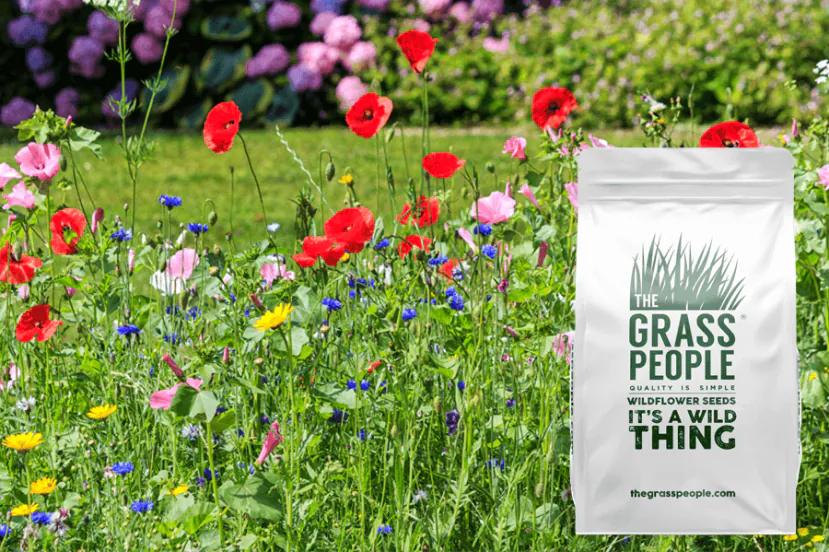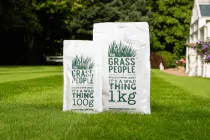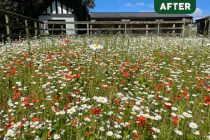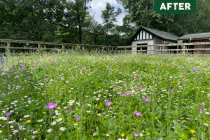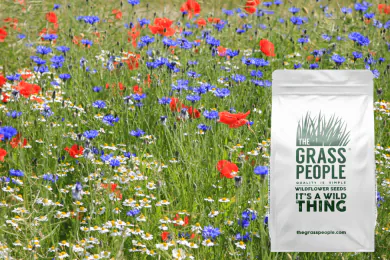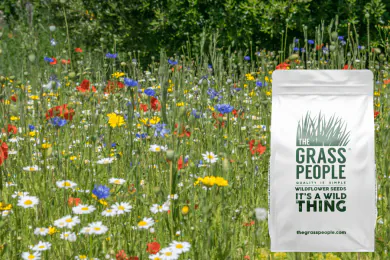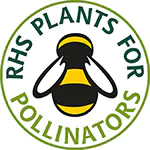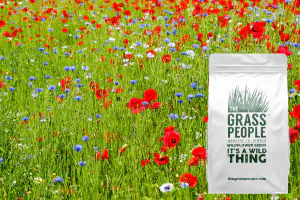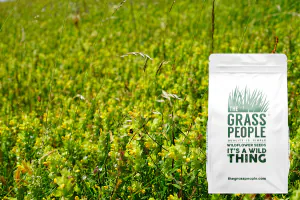Meadow Magic Wildflowers
- Luxury 100% UK Native Wildflower Mix
- Contains annuals and perennials for a flora-full meadow
- A vibrant and versatile mix that can be introduced to any garden
Please refresh the page in 1 minute to see the next delivery time.
How much do I need?
Simply enter the length and width of the area, to calculate how much you need.
Product Description
Meadow Magic is a quick to establish wildflower seed mix that's perfect for sowing in areas of disrepair, such as road verges, untouched gardens or derelict sites, to bring back some vibrancy. Meadow Magic can also be sown in beds, borders and pots to create a stunning arrangement of flora that is also RHS Plants for Pollinators approved. This luxury mix is made up of 100% wildflowers – no grass varieties are present in this mixture, and it is, therefore, a premium wildflower mixture. The annual species within the mixture will flower vividly throughout the year one of establishment, followed by the beautiful bloom of the perennial species over the coming seasons.
Mixture Breakdown
June – August
What colour is it?Violet
Annual or Perennial?Annual
Latin NameCentaurea cyanus
DescriptionCornflower was previously considered a weed in amongst its cornfield annuals companions but is now accepted and widely praised as one of its finest! We're not surprised - who could dismiss those electric blue blooms?
May – September
What colour is it?Purple
Annual or Perennial?Annual
Latin NameAgrostemma githago
DescriptionCorncockle is a pretty purple wildflower with tall stems and full petals and is a bright addition to any annuals mix. It is currently rare and endangered.
May – September
What colour is it?White / Yellow
Annual or Perennial?Perennial
Latin NameLeucanthemum vulgare
DescriptionImagine the daisy chain these would make! Oxeye Daisy is the largest member of the daisy family and its almost flat surface makes the perfect landing pad for bees and pollinators.
January - December
What colour is it?White / Brown
Annual or Perennial?Perennial
Latin NamePlantago lanceolata
DescriptionRibwort Plantain although not the brightest wildflower, certainly adds a natural diversity to your wildflower meadow. Its tiny white buds provide food for bees and pollinators whilst its seeds are great for Goldfinches.
June - October
What colour is it?Yellow
Annual or Perennial?Annual
Latin NameGlebionis segetum
DescriptionCorn Marigold is a bright ray of sunshine on a gloomy day. Its orange-yellow petals burst into life in June and last all the way through until October. Part of the cornfield annuals family, although this annual may have one showing - it’s a showstopper!
June - August
What colour is it?Red / Black
Annual or Perennial?Annual
Latin NamePapaver rhoeas
DescriptionCorn Poppy is a vibrant and bright addition to any meadow and easily recognisable and identifiable throughout the UK. Of course it has meaning for many, and also adds a colourful pop to any wildflower plot!
June - September
What colour is it?Purple
Annual or Perennial?Perennial
Latin NameCentaurea nigra
DescriptionCommon Knapweed can be mistaken for a thistle before it blooms, and once it does, it has magnificent starburst purple petals that resemble a firework display!
June - September
What colour is it?White / Yellow
Annual or Perennial?Annual
Latin NameAnthemis arvensis
DescriptionAlthough Corn Chamomile looks like a daisy, it is part of the cornfield annuals family. With its flat and almost-level surface it makes the perfect pit-stop for bees and pollinators.
March - November
What colour is it?Pink
Annual or Perennial?Perennial
Latin NameSilene dioica
DescriptionRed Campion has hot pink petals that make for quite the show stopper in your wildflower meadow, and can typically be found in woodland areas. Red Campion begins to flower once bluebells begin to fade, so if you notice this happening in your wildflower sward you can begin to look forward to their fuchsia blooms!
May - September
What colour is it?Pink / Green
Annual or Perennial?Perennial
Latin NameSanguisorba minor
DescriptionA perennial wildflower with toothed leaves and pink flowers, its leaves when crushed smell like cucumber and used to be used in salads!
May - September
What colour is it?Yellow / Red
Annual or Perennial?Perennial
Latin NameLotus corniculatus
DescriptionBirdsfoot Trefoil is part of the pea family and grows up to 35cm. It is well known for its yellow slipper like petals and red centre, which has given it the nickname of 'Eggs and Bacon'!
May - September
What colour is it?Blue
Annual or Perennial?Annual
Latin NameLinum utisatissimum
DescriptionThis species of wildflower was formerly used as a crop for oil and linen-making. This plant has tall, slender stems which produce attractive blue flowers with five petals.
May - October
What colour is it?White
Annual or Perennial?Perennial
Latin NameSilene latifolia
DescriptionThe white sibling of Red Campion, this wildflower still holds it on with its lengthy rayed petals. At night time it is said to produce a clover scent that is attractive to many bees and pollinators.
June – September
What colour is it?Yellow
Annual or Perennial?Perennial
Latin NameOenothera biennis
DescriptionEvening Primrose is a buttercup-like perennial that is well known for its medicinal benefits. The sole ingredient of Evening Primrose Oil, while it may be of use for some ailments, it’s particularly pretty just to look at!
June - September
What colour is it?Pink / Purple
Annual or Perennial?Perennial
Latin NameDigitalis purpurea
DescriptionFoxgloves are biennial wildflowers that when sown will reward you with blooms for two whole years. Their bright pink / purple bells are attractive to bees and pollinators who tunnel in to feed on its nectar.
May - September
What colour is it?Purple
Annual or Perennial?Perennial
Latin NameVicia sativa ssp. Segetalis
DescriptionCommon Vetch produces delicate purple flowers that make it a very desirable wildflower. It is considered a 'scrambling plant', which means it makes an extra special effort to climb to the sun and weave its way above many other wildflowers.
April - July
What colour is it?Yellow
Annual or Perennial?Annual
Latin NameLatin Name
DescriptionDespite its name, Black Medick is actually a yellow wildflower that resembles a clover. Just like a clover, it is exceptionally good at attracting bees and pollinators and due to its 'sprawling' ability, is particularly good at thriving in clay soils.
May – September
What colour is it?Purple / Pink
Annual or Perennial?Annual
Latin NameTrifolium pratense
DescriptionRed Clover is a popular perennial that despite its name, is actually purple! It's dome-shaped flowers are relatively low-growing which makes it the perfect fodder food for livestock but is also a fan favourite of weary bees who need a feed a little closer to the ground.
Usage Guide
● Remove any existing grass, plants or flora from the area where you plan to sow your wildflower seed. Failure to do this will produce poor results
● Further remove the top 5-10cm to reduce soil fertility
● Allow the area to cultivate for several weeks, and remove any weeds that may pop in the area during this time
● Do not be tempted to add top soil, compost or fertiliser to the area - wildflowers prefer low nutrient conditions
● After the cultivation period ensure to remove stones or any other debris and rake the area to create a fine, friable and level seedbed
● Scatter the seed at a rate of 5g per m2
● Rake the seed so that it is in amongst the soil
● Water the just-sown wildflower seed well
● If sowing in drought conditions, water as required to keep the area moist in the first 6 weeks after sowing
Read our full guide on how to manage your wildflower meadow here.
| Sowing Rate | 5g per m2 |
| When | For best results sow in March/April or in September |
Aftercare
End of year cut:
- We recommend doing this essential end-of-year cut in autumn.
- Your wildflowers are ready for their first cut when they have grown to 7cm and have gone to seedhead.
- This cut can be done using your lawn mower at its highest setting or using a strimmer.
Early spring cut:
- An early spring cut is ideal when your wildflowers are well-established.
- This early spring cut trims back meadow grasses and helps increase the density of the wildflowers.
- This cut also encourages wildflowers to grow better later that season.
- Cut before the end of April, or you may stunt their growth, and they could skip blooming that year.
Summer cut (optional):
- A cut between June and August can encourage the growth of wildflowers later in the season.
- Cut back to 7cm tall and remove the cuttings.
- This optional cut encourages new wildflowers to grow and flourish.
What to do with the cuttings (if you have annual wildflowers in the mix):
In dry conditions:
- If conditions will be dry for 5-7 days, you can let the cuttings lie on the ground so the seeds drop.
- Walk over, use a roller or shake the seedheads to encourage the seeds to fall and grow next season.
- Then remove the plant cuttings after a week and dispose of them in your garden waste bin.
In wet conditions:
- Lift the clippings if rainfall is forecast, and manually free up the seeds by crushing the seedhead to collect the seeds for replanting.
- When dry conditions return, scatter the seeds across your wildflower area.
- Alternatively, you can store your collected wildflower seeds in an envelope and replant them later.
For further reading, check out our guide on when and how often to cut a wildflower meadow.
The above photo depicts the variety of species you should expect to see in your wildflower display. Please note that certain species within this mix and all our wildflower mixes may become more abundant than others, and this varies based on the conditions in which they are sown. Taking this into consideration, your wildflower meadow will evolve and adapt year after year and change in appearance as certain species may become more dominant than others.
Product Questions
Product Questions
Thank you for your enquiry. It is really difficult to establish wildflowers in an area where there is already grass, and it is not something that we would recommend as it has varying degrees of success and we would not want you to be unhappy / disappointed with the results.
If you want to have a wildflower meadow, I would recommend picking an area and clearing it of any grass by digging it up and removing it, and any existing weeds etc. By also removing the top 5-10cm of soil after the grass has been removed, you can reduce the soil fertility which is ideal for wildflowers.
Meadow Magic is a very popular mix of ours and we have had lots of positive feedback from customers who sowed it back in September / October time last year, and is one that I would recommend if you want to see more flora than a dispersion of grass and flora. Your annuals will pop up in spring next year if you were to sow now, followed by your perennials.
If you have any other questions, feel free to email us at [email protected] and we will try and get back to you as soon as possible
This mix contains wildflower species that are on the RHS Perfect for Pollinators list - so they are recognised for their ability to attract bees and other pollinators by the RHS. All of our seeds are natural, there is no insecticides or coatings on our seeds.
We would recommend sowing the new seed when you mow your existing meadow. Seed to soil contact is vital to germination, so ensure your seed is lightly raked into the soil and watered for a successful bloom.
Also if I sow in September when will they grow and flower
Sowing wildflower in September will provide a bloom during the following Spring. Often wildflower seed needs the colder winter months to stratisfy.
Apologies for the delay in my response.
Given that you already have grasses we would second the opinion of sowing just annual wildflowers like that of Meadow Magic or Annuals Mix. We recommend sowing of wildflowers during Autumn to allow for a bloom in Spring.
We would recommend mowing any wildflower meadow once a year in September time, leaving the clippings on the ground for a week or two to allow the seedhead to fall back into the soil and then rake off the debris. In your case, we would recommend sowing the new seed just after you have raked off. We would not recommend further mowing as there will be very little growth during the winter months and in spring and summer we want the meadow to flourish.
Sorry for the confusion regarding the periods in which the wildflowers will bloom. Unfortunately, no the wildflowers will not be on display during winter months as the cold weather restricts their growth. With Meadow Magic the annual species produces an initial display of colour in the first year and the perennial species persist thereafter.
I hope this is helpful.
Thanks, Orla
There are two times in the year that we recommend sowing a meadow, one is spring and the other is autumn. Autumn is an ideal time because the seeds need to undergo the process of stratification (a freeze) to kick start their germination. If you were to sow the seed now, nothing will happen until next spring, early in the season. If you decide to wait until next year and sow in the spring then your meadow will flower in the summer.
We do have a few blog posts on our website that go into more details. I have copied the links below if you wish to read further.
https://thegrasspeople.com/can-sow-grass-seed-now/
https://thegrasspeople.com/when-sow-wildflowers/
You would need 0.48kg of wildflower seed.
